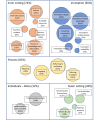Implementation of Machine Learning Applications in Health Care Organizations: Systematic Review of Empirical Studies
- PMID: 39586084
- PMCID: PMC11629039
- DOI: 10.2196/55897
Implementation of Machine Learning Applications in Health Care Organizations: Systematic Review of Empirical Studies
Abstract
Background: There is a growing enthusiasm for machine learning (ML) among academics and health care practitioners. Despite the transformative potential of ML-based applications for patient care, their uptake and implementation in health care organizations are sporadic. Numerous challenges currently impede or delay the widespread implementation of ML in clinical practice, and limited knowledge is available regarding how these challenges have been addressed.
Objective: This work aimed to (1) examine the characteristics of ML-based applications and the implementation process in clinical practice, using the Consolidated Framework for Implementation Research (CFIR) for theoretical guidance and (2) synthesize the strategies adopted by health care organizations to foster successful implementation of ML.
Methods: A systematic literature review was conducted based on the PRISMA (Preferred Reporting Items for Systematic Reviews and Meta-Analyses) guidelines. The search was conducted in PubMed, Scopus, and Web of Science over a 10-year period (2013-2023). The search strategy was built around 4 blocks of keywords (artificial intelligence, implementation, health care, and study type). Only empirical studies documenting the implementation of ML applications in clinical settings were considered. The implementation process was investigated using a thematic analysis and coding procedure.
Results: Thirty-four studies were selected for data synthesis. Selected papers were relatively recent, with only 9% (3/34) of records published before 2019. ML-based applications were implemented mostly within hospitals (29/34, 85%). In terms of clinical workflow, ML-based applications supported mostly prognosis (20/34, 59%) and diagnosis (10/34, 29%). The implementation efforts were analyzed using CFIR domains. As for the inner setting domain, access to knowledge and information (12/34, 35%), information technology infrastructure (11/34, 32%), and organizational culture (9/34, 26%) were among the most observed dimensions influencing the success of implementation. As for the ML innovation itself, factors deemed relevant were its design (15/34, 44%), the relative advantage with respect to existing clinical practice (14/34, 41%), and perceived complexity (14/34, 41%). As for the other domains (ie, processes, roles, and outer setting), stakeholder engagement (12/34, 35%), reflecting and evaluating practices (11/34, 32%), and the presence of implementation leaders (9/34, 26%) were the main factors identified as important.
Conclusions: This review sheds some light on the factors that are relevant and that should be accounted for in the implementation process of ML-based applications in health care. While the relevance of ML-specific dimensions, like trust, emerges clearly across several implementation domains, the evidence from this review highlighted that relevant implementation factors are not necessarily specific for ML but rather transversal for digital health technologies. More research is needed to further clarify the factors that are relevant to implementing ML-based applications at the organizational level and to support their uptake within health care organizations.
Trial registration: PROSPERO 403873; https://www.crd.york.ac.uk/prospero/display_record.php?RecordID=403873.
International registered report identifier (irrid): RR2-10.2196/47971.
Keywords: artificial intelligence; barriers; facilitators; health care organization; implementation; machine learning.
©Luigi M Preti, Vittoria Ardito, Amelia Compagni, Francesco Petracca, Giulia Cappellaro. Originally published in the Journal of Medical Internet Research (https://www.jmir.org), 25.11.2024.
Conflict of interest statement
Conflicts of Interest: None declared.
Figures


Similar articles
-
Health professionals' experience of teamwork education in acute hospital settings: a systematic review of qualitative literature.JBI Database System Rev Implement Rep. 2016 Apr;14(4):96-137. doi: 10.11124/JBISRIR-2016-1843. JBI Database System Rev Implement Rep. 2016. PMID: 27532314
-
Home treatment for mental health problems: a systematic review.Health Technol Assess. 2001;5(15):1-139. doi: 10.3310/hta5150. Health Technol Assess. 2001. PMID: 11532236
-
Signs and symptoms to determine if a patient presenting in primary care or hospital outpatient settings has COVID-19.Cochrane Database Syst Rev. 2022 May 20;5(5):CD013665. doi: 10.1002/14651858.CD013665.pub3. Cochrane Database Syst Rev. 2022. PMID: 35593186 Free PMC article.
-
[Volume and health outcomes: evidence from systematic reviews and from evaluation of Italian hospital data].Epidemiol Prev. 2013 Mar-Jun;37(2-3 Suppl 2):1-100. Epidemiol Prev. 2013. PMID: 23851286 Italian.
-
Sexual Harassment and Prevention Training.2024 Mar 29. In: StatPearls [Internet]. Treasure Island (FL): StatPearls Publishing; 2025 Jan–. 2024 Mar 29. In: StatPearls [Internet]. Treasure Island (FL): StatPearls Publishing; 2025 Jan–. PMID: 36508513 Free Books & Documents.
Cited by
-
Organization of services for severe chronic Noncommunicable diseases at first-level hospitals in nine lower-income countries: Results from a Baseline assessment of PEN-Plus initiation.PLOS Glob Public Health. 2025 May 5;5(5):e0004552. doi: 10.1371/journal.pgph.0004552. eCollection 2025. PLOS Glob Public Health. 2025. PMID: 40323986 Free PMC article.
-
Adoption of artificial intelligence applications in clinical practice: Insights from a Survey of Healthcare Organizations in Lombardy, Italy.Digit Health. 2025 Jul 10;11:20552076251355680. doi: 10.1177/20552076251355680. eCollection 2025 Jan-Dec. Digit Health. 2025. PMID: 40656847 Free PMC article.
-
Diagnostic Accuracy of Deep Learning Models in Predicting Glioma Molecular Markers: A Systematic Review and Meta-Analysis.Diagnostics (Basel). 2025 Mar 21;15(7):797. doi: 10.3390/diagnostics15070797. Diagnostics (Basel). 2025. PMID: 40218147 Free PMC article. Review.
References
-
- Secinaro S, Calandra D, Secinaro A, Muthurangu V, Biancone P. The role of artificial intelligence in healthcare: a structured literature review. BMC Med Inform Decis Mak. 2021 Apr 10;21(1):125. doi: 10.1186/s12911-021-01488-9. https://bmcmedinformdecismak.biomedcentral.com/articles/10.1186/s12911-0... 10.1186/s12911-021-01488-9 - DOI - DOI - PMC - PubMed
-
- Generating Evidence for Artificial Intelligence Based Medical Devices: A Framework for Training Validation and Evaluation. World Health Organization. 2021. [2024-11-04]. https://www.who.int/publications/i/item/9789240038462 .
-
- Mittermaier M, Raza M, Kvedar JC. Collaborative strategies for deploying AI-based physician decision support systems: challenges and deployment approaches. NPJ Digit Med. 2023 Aug 05;6(1):137. doi: 10.1038/s41746-023-00889-6. https://doi.org/10.1038/s41746-023-00889-6 10.1038/s41746-023-00889-6 - DOI - DOI - PMC - PubMed
-
- Shaw J, Rudzicz F, Jamieson T, Goldfarb A. Artificial intelligence and the implementation challenge. J Med Internet Res. 2019 Jul 10;21(7):e13659. doi: 10.2196/13659. https://www.jmir.org/2019/7/e13659/ v21i7e13659 - DOI - PMC - PubMed
Publication types
MeSH terms
LinkOut - more resources
Full Text Sources
Medical
Research Materials
Miscellaneous

